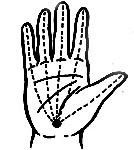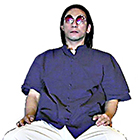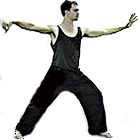Technical Background
This page is here for the people in chronic pain who are doing further due diligence in researching whether this service is for them. I don't expect people to read this page before scheduling an appointment. However, for those who may feel frustration in their journey of suffering in chronic pain and not being able to obtain relief, I have laid out in this page the phases one goes through from being injured and to being healed completely. The method of treatment offered herein should seem rational and founded in some kind of empiricism with respect to success in healing chronic pain.
Overview Of The State Of Thai Massage In America
It is pretty apparent that the vast majority of Western massage therapists in the USA who are practicing Thai Massage, Thai Yoga, or Thai Yoga Massage (the three common names for the same discipline) have been trained in the Northern or "Chiang Mai" style, which is renowned for its ability to relax and tonify the body.
Most of these Western Thai Massage therapists have been trained here in the USA in seminar format by the others who were lucky enough to have trained in Chiang Mai. Some have made their way to Chiang Mai to study firsthand and have ongoing relationships with these Chiang Mai schools.
The vast majority of these practitioners don't seem to understand that the "Bangkok" styles, which include the "Blind" style and "Wat Po" style, are very different in their approach compared to the "Chiang Mai" style...nor do they understand the role of the stronger techniques of these Bangkok styles in chronic pain therapy within the Thai framework.
In speaking with many of these Western massage therapists, it is hard not to get the sense that they feel their understanding and practice of Traditional Thai Massage is definitive, which is quite strange.
As these massage therapists have disseminated information about Thai Massage to the general public in the USA, the overall understanding of Thai Massage's amazing ability to relieve chronic pain has been obscured by a perspective that views Thai Massage as being the Chiang Mai style, with the Bangkok styles rarely being competently offered.
The average client in the USA has no idea about these distinctions and is, therefore, at a complete disadvantage in adequately assessing what criteria they should use in choosing a Thai Massage therapist and what is in their best interests for the kind of treatment they are seeking prior to scheduling a Thai Massage.
People suffering from serious chronic pain are therefore needlessly missing out on pursuing their recovery within a Thai Massage framework. Thai Massage is uniquely designed to treat any structural injury ("structural" here is defined as being related to muscles, tendons, ligaments, bones, and nervous system that provide structure for the body)...one need look no further.
The highest level practitioners of Thai Massage, which include the Blind therapists of Bangkok, know both the Bangkok and Chiang Mai styles and mix them to suit their clients needs. Without the Bangkok styles to deliver chronic pain therapy, the amazing stretching techniques from the Chiang Mai style do not fulfill their full potential.
Ironically, the kind of advanced stretching techniques favored in the Chiang Mai style can actually do damage to an unsuspecting Western client if the body has not been opened sufficiently with the kind of deep tissue work the Bangkok Thai Massage styles deliver prior to stretching. This situation is only compounded if the client is injured when receiving the massage. Thai Massage was created for Thai people in tropical Thailand whose hips, low backs, and ankles are generally much more flexible than Westerners due to the widespread practice of sitting on the floor and squatting on one's haunches and the tropical heat's effect on the body.
Most of the Thai's who are practicing in the USA are aware of this distinction between the Bangkok and Chiang Mai styles. They are also aware of the mystique that the Blind have in administering Thai Massage for therapeutic purposes and have a profound respect for the Blind and their role in chronic relief in Thai Massage.
-Daniel Carr
First and foremost thought behind this page as it relates to your treatment: the Blind Style of Thai Massage that will be used to work on you would not be nearly as effective had my technique not been corrected personally by a Master. This happened twice: first with Dr. Rong Rong Zheng in Tui Na, and then with Ajahn Yong Kiat in Thai Massage.
I am extremely fortunate to have created this kind of continuous working long term relationship with such a Master as Ajahn Yong Kiat. My technique has been corrected and expanded over 3 extended periods lasting months in the last decade in a private lesson format in Thailand. Rare is the massage therapist who has had this opportunity.
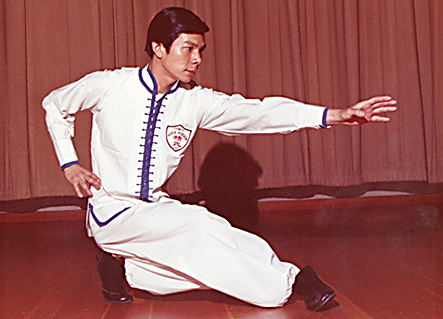 Grand Master Wong demonstrates a "Dragon" stance from Hsing Yi, a martial art that is invaluable for massage therapy application.
Grand Master Wong demonstrates a "Dragon" stance from Hsing Yi, a martial art that is invaluable for massage therapy application.A second thought: the ability to heal people with Blind Thai Massage is further enhanced by a continued practice of Tai Chi, Hsing Yi, and Kung Fu. One's physical power and sensitivity to be able to administer the correct amount of pressure and "electric feel" in treatments is greatly increased by a well developed practice of any martial art that focuses on internal energy/ch'i.
These kinds of martial arts are referred to as "Internal" because of the emphasis on body energetics or bioenergetcs. It is much easier to understand these arts when viewing them as directly linking a heightened sensitivity, concentration, and awareness on the electric structure of the nervous system. This kind of awareness is one of the main tools for creating power in these Internal martial arts.
In these arts, there is also an emphasis on being able to project your entire muscular/skeletal system directly into line projecting outward from your hand (or whatever body part is used for a strike). When examining Grand Master Wong's "Dragon" stance in the photo, it was quite clear that his entire body and awareness is aimed on a line in directly in front him.
A strong understanding of Hatha Yoga and its strategies for increasing flexibility, likewise, adds to a practitioner's ability to finish the treatment process by resetting the body. The understanding of Yoga poses/Asana further enhances one's ability to work with the stretching techniques found in both the Chiang Mai and Bangkok styles ONLY if the practitioner is extremely patient in coaxing the body to open up.
However, Hatha Yoga does not provide the same skill set that "Internal Martial Arts" do for a massage therapist who is concerned with manually resetting the peripheral nervous system and undoing scar tissue adhesions prior to the finishing stretches.
To reset the peripheral nervous system and undo scar tissue adhesions is a tricky affair, unfortunately. If it weren't so difficult, no one would be walking around in pain after seeing their massage therapist. One must possess an equal amount of both power and sensitivity to project into a client to do this correctly.
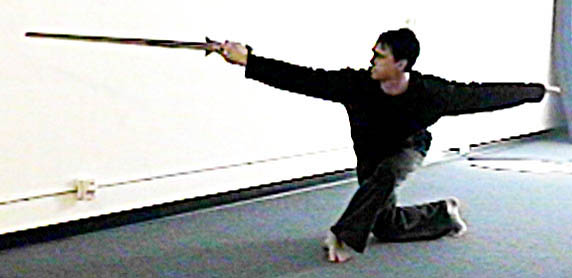 Tai Chi Sword
Tai Chi SwordTai Chi is arguably the best complimentary art for this purpose. However, expertise in the arts of Kung Fu, Hsing Yi, Chi Kung, Aikido, and Silat would fulfill this requirement. The best acupuncturists traditionally in China were the ones who had strong Tai Chi or Chi Kung backgrounds, the reason being is that they could transfer their own energy into their needling and bodywork techniques.
The main foundation for discipline, body energetics, and perspective in all of these esoteric practices came from having studied the arts of Kung Fu, Tai Chi, and Hsing Yi with Grandmaster Jack Man Wong for 14 years in the San Francisco Bay Area, starting with him at age 18.
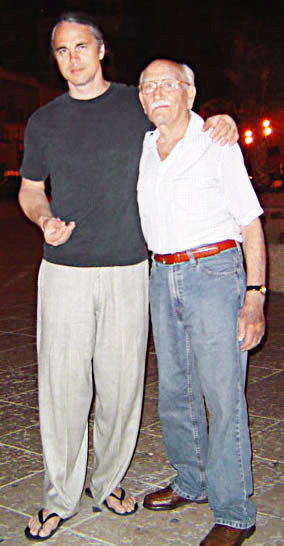 With my Grandfather
With my Grandfatherin Catania, Sicily
I was a student at UC Berkeley at the time and was being pulled away from academic endeavors by a fascination with the body energetics I was discovering in my Tai Chi practice. At first, my hands lit up from doing Tai Chi. With a little time, the chi' permeated my arms and started to root in my feet. It is an incredible feeling to have chi' flow through your body directed by your awareness. Once the process begins, most people are hooked.
It was this exploration of "ch'i"/body energetics in Chinese Martial Arts that later led to the further studies in Hatha Yoga, Eastern bodywork, Buddhism, etc...a "gateway drug" so to speak.
However, it was Grand Master Wong's unbelievable health, power, and youthful appearance that was the most motivating factor in pursuing these arts. He sprang around like a teenage gymnast in his 40's with a power that I coudln't fathom. When you banged arms with him, it felt like you were hitting a crowbar...this while he smiled at you at perhaps 20% of his power.
I would ask Grandmaster Wong as a nervous teenager if he thought I could make it as a Kung Fu Master like him, he would offer up choice bits like:
"Most people want something for nothing...too lazy."
"Nowadays, there are more teachers than students."
"Up to you..."
After this kind of initiation to this world of esoteric art and energetics, I always knew how to select teachers. All of my teachers are "Old School" Masters who learned their craft in China, India, and Thailand and are of a similar mind: you perfect your craft by undying allegiance to it. This means you are never satisfied with your current understanding and constantly strive to higher levels of mastery through sacrifice and discipline. I bring a strong work ethic to all of these arts in doing my best to follow these teachers' high example.
Thai Massage, Chinese Tui Na
And Real Pain Relief
I am personally beyond grateful to the arts of Thai Massage and Chinese Tui Na/bodywork for providing me with the opportunity to have a new body. I would most probably be limping around from all of the injuries I have accumulated over the years if not for these ancient arts. Instead, I have a body that is completely pain-free and able to perform at a very high level despite being ancient myself. These art forms should be respected for their power in reducing the suffering of all those who are in needless physical pain.
Getting The First Tools
In Chinese Tui Na
I received a Traditional Physical Therapy Certificate from the San Francisco College of Acupuncture back in 1990, a course that taught practical Tui Na (translates to "push/pull" with obvious implications to bodywork). A good friend of mine, Dr. Michael Clausen, ran the clinic and was also a student in Grand Master Wong's Kung Fu class. He knew and worked with many of the best Chinese Medicine people in the Bay Area.
Using his clinic as a backdrop, we had the opportunity to work with many Chi Kung, Kung Fu, and Tai Chi Masters visiting the Bay Area. It was an exciting time, since many of the Mainland Chinese, Taiwanese, and Hong Kong Masters were finally starting to share some of their secrets of bodywork. Many had "Family Style" secrets in Tui Na that were amazing for fixing chronic pain injuries, techniques that had been never shared with anyone outside their own families.
I came to Dr. Clausen's clinic initially as a patient and not as a student. It was just prior this period that I had suffered a case of sciatica from some particularly stupid lifting I had done to help my Mom move an incredibly heavy wooden desk. Sadly, even after having practiced Tai Chi for almost decade, I hadn't the confidence in Eastern medicine at this point to throw myself fully into the process for this case of sciatica.
With health insurance at the time favoring orthopedic surgeons, physical therapists, and chiropractors, I went through gauntlet of treatments that left me in constant pain, broke, demoralized, and convinced my career in Martial Arts would be cut short. I thought the happy part of my life was over with no one to rescue me.
The sciatica was caused by the following injuries in sequence:
-
My knee was kicked in a Karate class as a 6th grader, causing it to seize up for around one week. It remained a perpetual issue/"the weak link of my body" until I traveled to Thailand at age 40 where Yong Kiat fixed it. The kick did damage to the femoral nerve just above the knee.
-
I suffered a hip "pointer"/hyper-extension on my left side when I was 25 years old after throwing too many kicks in one work out. The knee injury on that side contributed to this misfortune, with the femoral nerve on the left side seizing up now from the knee to the hip socket.
-
I lifted a heavy wooden desk by myself and carried it down a flight of stairs at age 27. My left knee and hip pointer had now spasmed in unison all the way through the hip to the low back, pulling hard on the left side of the lumbar vertebrae and causing nerve impingement on the right side. This, an aggravation of a historical injury on my left side, resulted in sciatica running down my right leg.
This sequence is my specific "thumbprint" for my sciatica injury. Any one with a chronic pain injury will normally have a number of historical injuries link up to form a larger "matrix" that will manifest as a more serious condition. Keep this in mind as you continue reading.
Thankfully Dr. Clausen persuaded with me to let him have a go at my sciatica. He got me back to about 60% healed after a series of treatments using a combination of Acupuncture and Tui Na. I was too broke to receive further treatment at that point, but was more than happy for the miracle turnaround given what I had been through. If you feel 10% better after one treatment, that is reason enough to pop champagne...so being 60% better in 4 treatments was more than I could ask for.
Having no choice, I turned to my Tai Chi practice to push me the rest of the way out of pain, and it worked its magic. Chi Kung and Tai Chi can do amazing things with the nervous system as therapies to relieve pain. Within a couple of months, I was completely active and out of any kind of acute pain from the injury...though the cause of the injury was still lingering under the surface of this success in the form of hip tightness and occasional knee soreness. My flexibility in this part of my body was still quite limited even though pain was gone.
It should be noted that I was quite accomplished at Tai Chi when I started my rehab for the sciatica after Dr. Clausen's treatments. Had I attempted just to use Tai Chi alone, I doubt I would be out of pain even now. Yoga would have probably made things worse.
This is something many Tai Chi and Yoga instructors don't understand, especially if they have not personally rehabbed a serious injury: these arts are limited in what they can accomplish with respect to chronic pain and complete recovery. While excellent for resetting the peripheral system if done with the utmost care, neither of these modalities can undo scar-tissue adhesions. This has to be done manually.
Acupuncture is similar to Tai Chi and Yoga in this respect. A great Acupuncturist will use needle work to open up the peripheral nervous system and then Tui Na to undo scar-tissue adhesions. If someone experiences a lack of success using Acupuncture to solve a chronic pain issue, it usually because of a lack of Tui Na treatment techniques by the administering Acupuncturist.
Superior Tui Na technique is guarded like a trade secret, so one cannot assume that every Acupuncturist has an opportunity to study advanced Tui Na with a Master. Sadly, the state of California has moved away from Tui Na curriculum in its board testing of Acupuncturists towards herb pharmacology, and the major schools have followed suit. Excellent Tui Na is extremely hard to find these days in the USA.
This was all explained to me by Dr. Clausen as I was working through my rehab. It was at this point that I began studying Tui Na bodywork with Dr. Clausen at his clinic. I was beyond sold on Eastern bodywork that this unassuming Acupuncturist friend of mine could do what a top Orthopedic Surgeon, his Physical Therapist, and a top Chiropractor could not. Once you have been healed in this way, you understand that Western medicine has its place, as does Eastern. The world is much better off with both working together in combination rather than viewing them antagonistically.
It was a couple years later that this point would be driven home for good. I met and trained with Dr. Rong Rong Zheng from Shanghai in 1992, and she would forever change my understanding of medicine, physicians, and healing.
Dr. Zheng is the most knowledgeable doctor I have ever seen in action and now runs a thriving practice in San Francisco treating cancer patients in cooperation with UCSF, this while doing research on bioenergetics at Stanford University. Her program with the UCSF Oncology Department is a combined therapy treatment of acupuncture, herbs, and meditation pre- and post- chemotherapy and radiation therapy for cancer victims. Her survival rate in this regard is unmatched, and her work was officially honored at her 70th birthday party banquet by the faculty of UCSF.
Her background includes being trained as surgeon at John Hopkins in Shanghai, receiving an OMD/Doctorate in Traditional Chinese Medicine in Shanghai, and being the head of the Shanghai Chi Kung Research Institute after a long stint as "Riverboat Doctor" in rural China.
She was, unfortunately, "re-educated" during the Cultural Revolution in Maoist China for being part of the "bourgeoisie" and relocated in the Chinese countryside where she was assigned her duty of being a "Riverboat Doctor" where masses of people would come in boats to her clinic on a pier to receive free treatment. It was in this capacity that she treated thousands of people over the course of her relocation. As such, she had ample opportunity to test her Tui Na techniques with many of the farmers and laborers she had as chronic pain patients and document the results.
She utilized a set of techniques in massage treatment I had never experienced previously. It was extremely effective, yet painful, and I was amazed at how much progress one could make in short period of time. I had been referring her a number of my students, friends, and relatives to her for treatment, all of them in awe of her ability to heal chronic pain conditions they assumed were permanent. She even fixed my own Father's bad back which had become chronic in his mid-50's. I even became her client at one point to further undo the lingering tightness in my left hip which had become inflamed from full contact fighting.
After seeing Dr. Zheng as a patient a number of times for treatments on my hip, she eventually revealed to me the logic and application of her Tui Na technique for eliminating scar tissue deposits in the muscles. "Investment in loss" is a concept in Taoism that gets played out in these type of situations: Dr. Zheng demonstrated and explained her technique as she worked on and helped heal my injuries.
I am quite fortunate to have Dr. Zheng as a good friend and visit her regularly when I travel to the SF Bay Area. She jokes that she is my "Second Mom", which is good luck for me. She has always been willing to answer any questions on my Chi Kung practice and was instrumental in explaining a level of alchemy for my Tai Chi practice at the same time she was explaining the Tui Na techniques to me.
Dr. Zheng's Tui Na techniques, which break up scar tissue and liberate the injured muscles while undoing whatever spasms may exist locally, were so effective that I never felt the need to utilize anything else when doing bodywork on people at my Kung Fu studio. People limping into my studio with sciatica, knee and ankle injuries, tight necks and shoulders, etc. would walk out with amazing levels of relief. If they practiced Kung Fu, Tai Chi, or Yoga at the studio, the results would be even more dramatic.
The story could end here quite happily, but there are a couple of issues with Dr. Zheng's style of Tui Na technique:
-
By it's very nature, the technique is excruciatingly painful, which is too difficult for most people to handle: Clients would dread coming in for a second treatment. Even the proudest and grittiest of Kung Fu students would cringe and sometimes cry during these sessions.
-
The results from the first treatment were good enough that most people never fully completed their rehab by showing up for further treatment or practicing Yoga and/or Tai Chi. There is not a complete set of structural resets to go with this Tui Na technique, as there is with the stretches of Thai Massage, so one's work in either Yoga, Chi Kung, or Tai Chi Ch'uan was the only way to accomplish this. Most clients either lacked the time or desire to finish the job on their own time.
-
Most people are not physically aware enough to understand where their injuries originate and end in the body, i.e. the "thumbprint". They know where they feel pain locally, but they don't know the exact location of every muscle that is affecting that injury. For example, pain in the low back can caused by muscle torn in the front of the hip, which can be linked to muscles torn around the knee. Relief locally did not guarantee elimination of the condition that was the root of the problem. A more comprehensive diagnosis and treatment of the body was necessary to fully eradicate these historical causes of chronic pain completely. In my own case, the knee injury in 6th grade had rippled forward in time to cause sciatica on my right side at age 27, two seemingly unrelated events.
In the end, it turns out that Dr. Zheng's Tui Na techniques perfectly compliment Thai Massage. In fact, there are comparable techniques built into the higher levels of Blind Thai Massage treatments that, while not being quite as fast (or painful) in removing scar tissue as Dr. Zheng's Tui Na technique, are better for manual peripheral nervous system resets. Having both sets of technique are best for use in chronic pain treatment.
A Continuing Journey To Thailand
I visited Thailand for the second time back in 1995 to further my studies in Muay Thai, the Thailand style of Kick Boxing. I had received a few Thai Massages the first time I had traveled to Thailand in 1985, but it was during this trip that I was taken by some of the trainers and fighters I was working with to some expert Thai Massage therapists. The trainers knew the best people locally and were eager to get treatment themselves (I was buying, of course).
Their work was so amazing that I vowed I would return again to seek training under true masters of the art. They were able to put me to sleep while using an incredible amount of pressure in their techniques. I felt so flexible and deeply relaxed after these treatments that it defied my understanding of bodywork at that time. With the daily punishment I was receiving in Muay Thai, these treatments provided me with the ability to recover in a fraction of the normal time.
I starting teaching Kung Fu and Muay Thai again when I returned from Hawaii to the Mainland in 1996. From there, I opened up a formal studio in late 1998 in Los Angeles, which meant putting off going to Thailand to study massage until some later date in the future.
As the school became more successful, a certain stress overtook me: while I was getting locked down into the business by the momentum the school was experiencing, I was also feeling the lingering effects of the old injuries that had not completely healed in my left hip and knee. I had re-aggravated them while teaching, which demonstrated that even though I had felt no pain for almost decade the injured areas were still the weak link in body.
I became increasingly concerned that the effects these injures would become problematic and limit me in my training and teaching in the future. My left knee was continually aching from constantly teaching after re-aggravating it, and my left hip was still slightly impacted and was not as flexible as the right hip. It was finally time to head to Thailand to put the art to the test: if I could return with these injuries fully healed, I would really have something to share.
After doing extensive research on the various practices of Hatha, Raja, Kundalini, and Japa Yoga from books directly from Yoga schools in India (the Bihar School of Yoga was my main source), I also knew that my grasp on traditional Yoga was limited. I felt doing this research that most teachers in the USA lacked an authenticity in the complete practice of Yoga, with plenty of gaps in understanding what the best Hatha Yoga practices are for injury rehabilitation. America's obsession with Asana practice had produced some amazingly flexible Yoga teachers, but the true essence of Yoga had been seemingly lost by its commercialization and the proliferation of unqualified teachers.
As it was impossible to further my studies with the intensity I wanted here in the USA with respect to Thai Massage and traditional Hatha Yoga, I set a date to travel to both India and Thailand as a student in search of knowledge in late 2002, handed over the Kung Fu studio to another teacher, and packed my bags.
Thailand, Two Regional Massage Zones:
Bangkok and Chiang Mai
Where does one start to learn Thai Massage in Thailand? If you end up in Bangkok, your best bet is:
WAT PO, BANGKOK:
"WHERE IT ALL BEGINS IN BUILDING
A FOUNDATION IN THE BANGKOK STYLE"
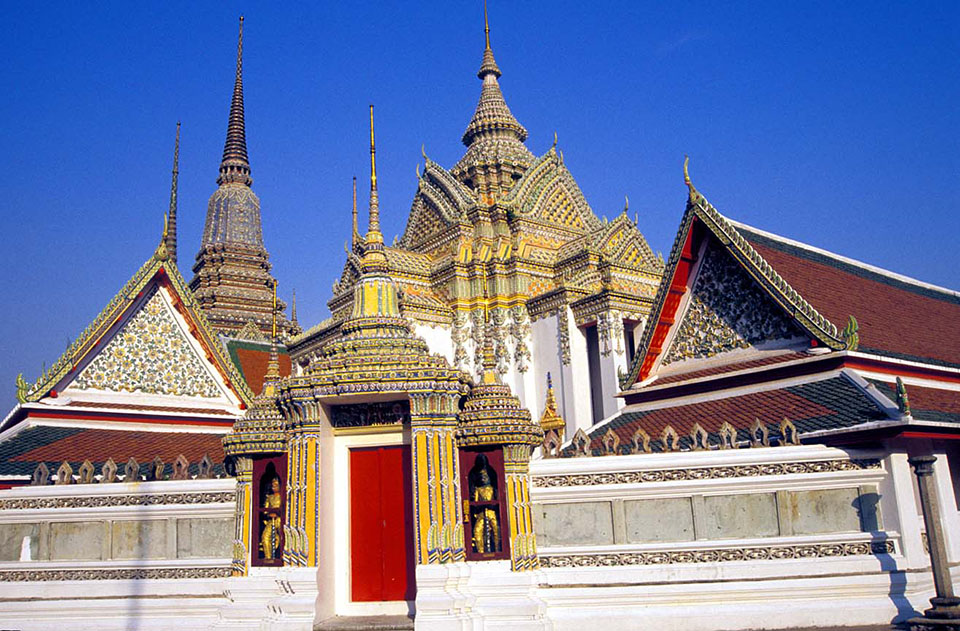 Wat Po is one of the most famous temples in Thailand.
Wat Po is one of the most famous temples in Thailand.In Bangkok, 95% or more of the foreigners looking for instruction in Thai Massage go to Wat Po to begin their journey. The instruction here ranges from excellent to poor, with some teachers able to communicate easily with the foreigners, others' English woefully inadequate.
The teachers rotate from giving massages on the temple grounds (mainly to foreigners, as in the below picture) to teaching duties. If you are lucky, you will be placed in a group of no more than 6-8 foreigners during the duration of your training. The Thai's train separately from the foreigners, so they do not face this communication issue.
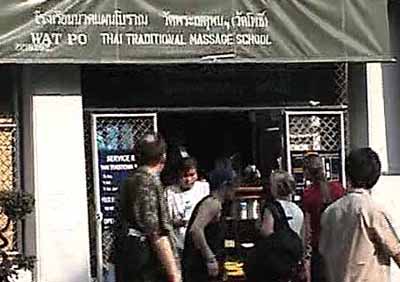 Wat Po is one of the most
Wat Po is one of the most famous massage schools in Thailand.
I received certification from Wat Po, but knew that this was just the beginning with respect to a serious effort. While their massage represented the collective efforts of the best minds in Thailand with respect to Thai Massage, the introductory program did not allow enough time for professional bodyworkers to hone their craft. I left there feeling like I had just had a great introduction to Thai Massage (Currently, a more comprehensive 200 hour program is now offered which was not offered when I attended their school).
Literally the day I completed the introductory program, luck hit me in a way that I couldn't fathom at that moment. The owner of the guesthouse where I was staying while completing program, a shrewish Yuppie of a Thai whose presence I had avoided at all costs, let me know in no uncertain terms when she saw my diploma in hand that I was still basically incompetent after the Wat Po program...just like all of the other foreigners that had come before me to her guesthouse.
The glee with which she said it pushed me a bit, enough so that I challenged her to let me know where I could receive a real education in Thai Massage. After looking me up and down for an uncomfortable minute, she did, which baffles and amazes me to this day. This woman changed my life forever...
Zounds, sir, you are one of those that will not serve God if the devil bid you. -Othello, William Shakespeare
She told me where to go...where she went to receive massages...and I went straightaway: Pisit Thai Massage.
PISIT THAI MASSAGE:
"WHERE D0 THE BLIND GO TO LEARN
THAI MASSAGE IN THAILAND
?"
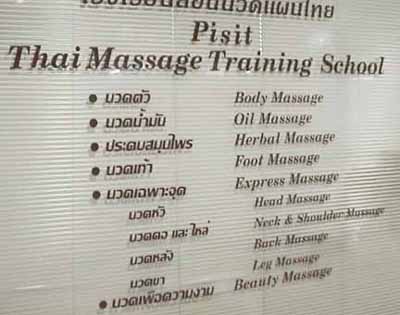 Pisit Thai Massage School was the premiere massage school for the blind in Bangkok.
Pisit Thai Massage School was the premiere massage school for the blind in Bangkok.Unfortunately, the subscript should now read, "Where did the blind go to learn massage in Thailand?" Ajahn Pisit passed away in the 2012 and his daughter Gop shut down the school for reasons unknown. More about that later on...
Ajahn Pisit Benjamongkonwaree was an icon in Thai Massage in Thailand. He was really one of the great torchbearers bringing forward Thai Massage from its Buddhist origins and antiquity to the modern day Thailand. Ajahn Pisit was regularly advising and consulting the government on Thai Massage. He was chosen to be the Technical Director of the Thai Massage Revival Project that was commissioned by the Thai government to overhaul and standardize Thai Massage as a national health resource in 1985.
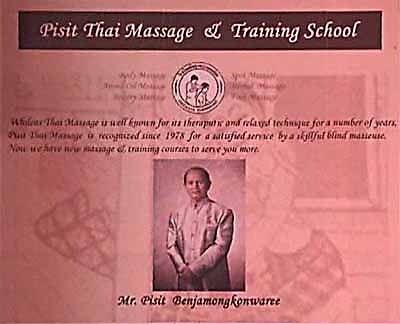 Ajahn Pisit had been teaching the
Ajahn Pisit had been teaching theblind in Bangkok since 1978.
Ajahn Pisit was famous in Thailand for teaching massage to the blind. His school and clinic were always busy, as his blind massage therapists were considered to some of the best in Bangkok.
Many of these blind therapists came from poor farming families, where their disability made them a liability instead of an asset to the farms. If not from farms, typically they were from poor families. Ajahn Pisit had made it possible for many of these blind people to earn more money than the rest of their families, and most of therapists actually sent money to their poorer loved ones.
His school was a completely different scene than Wat Po. Wat Po gave out certificates to non-bodyworkers who were basically taking the class like a hobby. In fact, it was difficult not to receive certification. A British woman who was in my group and was so lost that I would cringe when she touched me received a certificate.
When I first walked in Pisit's school, two Italians were fighting with one of the staff over them failing the course and there not being enough time to repeat it before their visa expired. "Too bad," they were told. "Try harder next time." They received no certification, even though they had been there for 4 months training, because they had failed their practical examination. Very old school, I thought...if you can't impress the teachers with your technique before leaving, you get nothing.
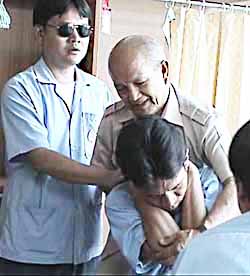 Ajahn Pisit instructs
Ajahn Pisit instructsthe blind in Bangkok.
I walked into Pisit's school not looking to get a certificate, but as a truly motivated student who wished only to hone his craft. My attitude made me a big favorite of Ajahn Pisit's right away, as most of the Westerners were only concerned with securing certification and drove the staff crazy with their talk about it. I just dug in and practiced so hard that I would have to ice my thumbs nightly (yes, you can do this...fill a wine glass with ice, then water, and then soak your thumbs...you might get some sleep even though your thumbs were throbbing and be able to work the next day).
I spent over four months training at his school everyday, spending additional money to massage his blind therapists in my spare time outside of class so they could continue to correct and expand my technique. My attitude and insatiable desire to learn was rewarded a thousand times over, as I made friends with "Yong Kiat", one of Ajahn Pisit Benjamongkonwaree's top massage therapists, who would continue to teach me long after I finished Ajahn Pisit's program.
Yong Kiat:
THAI MASSAGE MASTER EXTRAORDINAIRE
Yong Kiat and I would sit outside the school on a bench in a hallway day after day without talking much. It was hard to tell if he was a massage therapist or a blind helper at the school because he didn't wear the blue shirt uniform the others wore. With his long hair and stoic attitude, he was someone I gravitated towards out of curiosity.
I blurted out on the bench at one point that he looked like a rock-star. To my amazement, he shot back to me in pretty good English that he appreciated the compliment, but that as a musician, he was only writing songs for commercials on the radio. After that, he and I would sit on this bench trying to work out jingles for a department store that had hired him for that purpose.
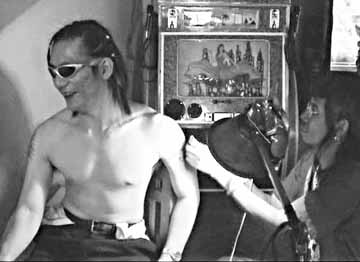 Yong Kiat gets a tattoo of a Garuda or a Thai "Kut" from the talented Mr. Lek with some of the money he earned from tutoring me. I am off camera, asking if it hurts.
Yong Kiat gets a tattoo of a Garuda or a Thai "Kut" from the talented Mr. Lek with some of the money he earned from tutoring me. I am off camera, asking if it hurts.I came to find out that he was the best massage therapist at Pisit's school and didn't wear the uniform because he had too much style to be bothered with such mundane details. I begged him to tutor me privately, and he accepted my request after feeling me out for a couple of weeks. We established such a good working relationship that he was assigned to teach my advanced "Therapeutic Acupressure For Local Pain" course by Ajahn Pisit, one on one. Of course, I had to pay a bit more for this.
What can I say? I lucked out. Yong Kiat is the most amazing bodyworker I have ever met, having mastered both the Chiang Mai and Blind styles of Thai Massage, countless routines of two person stretches, and numerous treatments for all types of conditions. I showed my digital video footage of Yong Kiat working to Dr. Zheng, and she watched with her mouth open, marveling at his technique. One can receive no higher praise than that.
I trained with Yong Kiat privately for almost three months outside of the blind school at his apartment in 2002, and he had me film him to catalog all of the techniques that he had mastered up to that point. Needless to say, my thumbs were in excruciating pain in this period...ice, ice, ice...and I felt privileged to have such a video library for personal reference.
Yong Kiat also took me to his favorite Thai Massage establishments in Bangkok. Where does a blind Thai Massage expert go to get a Thai Massage? He took me to a number of his favorite places, explaining and teaching me the techniques from the various Thai Massage masters we visited. In the process, I sampled many different versions of the two styles in combination from some of Bangkok's best.
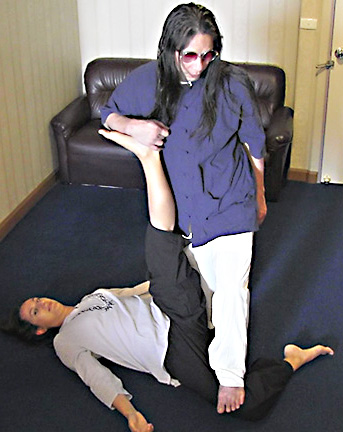 Yong Kiat hard at work, demonstrating
Yong Kiat hard at work, demonstratingstretches for a promising Italian student named Roberta who has a chornic pain practice in Holland.
I also learned advanced forms of Ajahn Pisit's routines and treatments from Yong Kiat. With his help, I actually received certification from their school in both massage routines and chronic pain therapy. Ironically, having not cared about the certificates, I received two of them.
Ajahn Pisit's routine in the Blind style of Thai Massage is treatment enough to fix any structural injury that is not related to torn cartilage or tendons. It is also a tonifying energetic treatment without parallel; it balances and circulates energy in the body as well as any acupuncture treatment available.
Yang Kiat's supplemented Ajahn Pisit's routine with an array of sophisticated techniques and stretches to provide a client with the greatest range of possibility.
Yong Kiat fixed my most problematic historic injuries using these techniques to the point where I felt confident that years of untold damage from training while still partially injured had been corrected: my knee had stopped aching finally and my hip had opened up to the point where kicking with my left and right side felt identical.
This should be repeated: my knee, which had ached almost every day for almost a decade, stopped aching. I haven't felt any such aching since then. In fact, I have completely forgotten that the area was injured and have to think about what it felt like to try to remember the pain.
Upon returning to USA armed with this new knowledge, amazing successes piled up upon my return. However, I also heard a lot of the same crying in the process as I had with Dr. Zheng's Tui Na techniques. Yong Kiat's and Pisit's methods were strong medicine, much like Dr. Zheng's. Clients would moan and fret about receiving treatments. One client would even hyper-ventilate before I even started in anticipation of what was to follow. It was not as bad as before, but it was still a problem.
I knew I had to soften things up to make the treatments more palatable for American sensibilities. I also wanted to review more with Yong Kiat, so I went back to Thailand again in 2006, some 4 years later.
CHIANG MAI:
THE GREAT, SOFT NORTH
In 2006, I returned to Thailand to study with Yong Kiat again. We expanded the number of therapy routines dealing with very problematic situations, more complicated routines that could only be introduced after an understanding in the more basic therapy routines had been accomplished.
These sessions were incredibly fruitful and left me with more material than I could possibly digest in the next few years. Having finished this, Chiang Mai was next on the agenda.
The average American does not hear much about Chiang Mai, but on the international traveler circuit Chiang Mai is well known for its cheaper-than-Bangkok prices, laid-back atmosphere, and variety of recreational activities. Many organized tours now travel to Chiang Mai for a combination of vacation and massage instruction. With a number of great institutions teaching massage in Chiang Mai, it is definitely worth the trip.
The word in Bangkok was that the Shivagakomarpaj Old Medicine Hospital was the most reliable institution for study. After inspecting all of the schools around town and quizzing some local Thai's, I concurred with this assessment.
As it turns out, it was an amazing experience to train there. The teachers spoke perfect English, executed the routines with precision, and piled on the material so hard and fast that I was left gasping at the task of keeping up with the material. One talented Scottish bodyworker would freak out daily and scream at them, "You are going too bloody fast!" The less knowledgeable of the bodyworkers there did not understand his concerns, but I did. The amount routine they cram in the time you are there is mind-boggling, IF YOU INTEND TO MASTER IT.
The routine they teach is their strongest selling point as well: it is so thorough that it can be used as an excellent preliminary massage prior to doing more rigorous Blind style techniques for therapy on any body part. It perfectly complements the Blind Style as a warm-up routine for the deeper chronic pain techniques, which is why so many of the top Blind therapists in Bangkok would switch back and forth between these two styles.
I kept a fairly low profile at the Old Medicine Hospital, but that didn't stop the Thai instructors from constantly quizzing me about where I had studied previously. They were pretty open to hearing about Yong Kiat's stronger Blind style methods, and few of them actually had me work on some more problematic injuries that their massage failed to address. Their program was excellent, and I was happy to receive certification and move on.
Mama Lek's Nerve Touch School was next on the tour. Jack, Mama Lek's son who taught classes there, is one of the best bodyworkers I have ever seen in action, second only to Yong Kiat...in fact, he is unbelievable. He seamlessly moved through routines and stretches in a way that I had only seen in Yang Kiat. Lacking the visa time to stay longer, I received their most bare bones certification and intend to return some day to study Jack's method more thoroughly.
Jack told me that Shivagakomarpaj and Nerve Touch are the two original schools of Northern Style Chiang Mai massage, and many of their students have opened up the newer schools in Northern Thailand. Some have become virtual "Rock Stars" on the traveler circuit, with Ajahn Pichet and Ajahn Sinchai being talked in the traveler circuit about with the same reverence as Jack.
However, none of the the Chiang Mai schools had the same set of techniques that the Blind style has for fixing chronic pain injuries. This would only be verified one more time as I traveled to Thailand again in 2012.
HERE AND NOW IN THAILAND
I am here in Thailand again and will update the piece in the future. Check back for updates.
HEADING BACK TO LA
At present, I am mainly using the Shivagakomarpaj routine with first time clients. When I find embedded injuries during this routine, I will give the client the opportunity to greenlight me to use Blind Style techniques for chronic pain therapy. It is up to the client to decide the pain-threshold of the treatment, not me. We will work the injuries every time, how much is up to the client.
For people with a low pain-threshold, there is really no problem other than the a bit of extra money it will cost. Generally, the more pain you can bear in treatment, the faster the treatments will do their magic...then less money you have to spend. If you don't mind paying for an extra treatment or two, we should be able to keep any discomfort to a minimum.
For pricing and other information about treatments, please consult the "What To Expect" page.
To learn more about strategies and techniques for injury rehabilitation, please to the "Injury Rehabiitation" page.
To learn more about Thai Massage treatments, please go to the "Thai Massage Theory" page.
